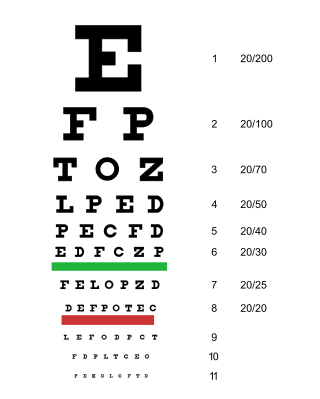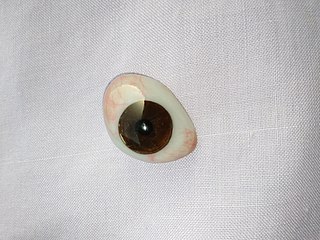Domination or dominant may refer to:
Lazy eye refers to several specific ophthalmic disorders:
Ocular rosacea is a type of rosacea that affects the eyes. Signs and symptoms generally consist of redness, irritation or burning of the eyes. Affected individuals may also feel that there is something, such as an eyelash, in the eye and frequently have redness of the nose and cheeks as well. Complications include corneal ulcer.

An eye examination, commonly known as an eye test, is a series of tests performed to assess vision and ability to focus on and discern objects. It also includes other tests and examinations of the eyes. Eye examinations are primarily performed by an optometrist, ophthalmologist, or an orthoptist. Health care professionals often recommend that all people should have periodic and thorough eye examinations as part of routine primary care, especially since many eye diseases are asymptomatic. Typically, a healthy individual who otherwise has no concerns with their eyes receives an eye exam once in their 20s and twice in their 30s.
Artificial eye may refer to:
Ocular hypertension is the presence of elevated fluid pressure inside the eye, usually with no optic nerve damage or visual field loss.
Retinal degeneration may refer to:
Larva migrans generally refers to disease caused by the migration of the larvae of a helminth to various tissues. Some variants of larva migrans include:
In scaled reptiles, the ocular scales are those forming the margin of the eye. The name originates from the term oculus which is Latin for 'eye' and, in the broadest sense, refers to a scale associated with the eye. The numbers of these scales present, and sometimes the shapes and sizes, are some of many characteristics used to differentiate species from one another.
In scaled reptiles, supraocular scales are (enlarged) scales on the crown immediately above the eye. The size and shape of these scales are among the many characteristics used to differentiate species from each another.
Ocular ischemic syndrome is the constellation of ocular signs and symptoms secondary to severe, chronic arterial hypoperfusion to the eye. Amaurosis fugax is a form of acute vision loss caused by reduced blood flow to the eye; it may be a warning sign of an impending stroke, as both stroke and retinal artery occlusion can be caused by thromboembolism due to atherosclerosis elsewhere in the body. Consequently, those with transient blurring of vision are advised to urgently seek medical attention for a thorough evaluation of the carotid artery. Anterior segment ischemic syndrome is a similar ischemic condition of anterior segment usually seen in post-surgical cases. Retinal artery occlusion leads to rapid death of retinal cells, thereby resulting in severe loss of vision.

Fixation or visual fixation is the maintaining of the gaze on a single location. An animal can exhibit visual fixation if it possess a fovea in the anatomy of their eye. The fovea is typically located at the center of the retina and is the point of clearest vision. The species in which fixational eye movement has been verified thus far include humans, primates, cats, rabbits, turtles, salamanders, and owls. Regular eye movement alternates between saccades and visual fixations, the notable exception being in smooth pursuit, controlled by a different neural substrate that appears to have developed for hunting prey. The term "fixation" can either be used to refer to the point in time and space of focus or the act of fixating. Fixation, in the act of fixating, is the point between any two saccades, during which the eyes are relatively stationary and virtually all visual input occurs. In the absence of retinal jitter, a laboratory condition known as retinal stabilization, perceptions tend to rapidly pass away. To maintain visibility, the nervous system carries out a procedure called fixational eye movement, which continuously stimulates neurons in the early visual areas of the brain responding to transient stimuli. There are three categories of fixational eye movement: microsaccades, ocular drifts, and ocular microtremor. At small amplitudes the boundaries between categories become unclear, particularly between drift and tremor.

An ocular prosthesis, artificial eye or glass eye is a type of craniofacial prosthesis that replaces an absent natural eye following an enucleation, evisceration, or orbital exenteration. The prosthesis fits over an orbital implant and under the eyelids. Though often referred to as a glass eye, the ocular prosthesis roughly takes the shape of a convex shell and is made of medical grade plastic acrylic. A few ocular prostheses today are made of cryolite glass. A variant of the ocular prosthesis is a very thin hard shell known as a scleral shell which can be worn over a damaged or eviscerated eye. Makers of ocular prosthetics are known as ocularists. An ocular prosthesis does not provide vision; this would be a visual prosthesis. Someone with an ocular prosthesis is altogether blind on the affected side and has monocular vision.
Ocular albinism is a form of albinism which, in contrast to oculocutaneous albinism, presents primarily in the eyes. There are multiple forms of ocular albinism, which are clinically similar.

Ocular albinism type 1(OA1) is the most common type of ocular albinism, with a prevalence rate of 1:50,000. It is an inheritable classical Mendelian type X-linked recessive disorder wherein the retinal pigment epithelium lacks pigment while hair and skin appear normal. Since it is usually an X-linked disorder, it occurs mostly in males, while females are carriers unless they are homozygous. About 60 missense and nonsense mutations, insertions, and deletions have been identified in Oa1. Mutations in OA1 have been linked to defective glycosylation and thus improper intracellular transportation.
Oculus, may refer to the following
Santosh Gajanan Honavar is an Indian ophthalmologist and is currently the Honorary General Secretary of the All India Ophthalmological Society; Director of Medical Services ; Director, Department of Ocular Oncology and Oculoplasty at Centre for Sight, Hyderabad; and Director, National Retinoblastoma Foundation. He was the Editor of the Indian Journal of Ophthalmology and Indian Journal of Ophthalmology - Case Reports, the official journals of the All India Ophthalmological Society from 2017 to 2023.
Ocular hypotony, or ocular hypotension, or shortly hypotony, is the medical condition in which intraocular pressure (IOP) of the eye is very low.
This page is based on this
Wikipedia article Text is available under the
CC BY-SA 4.0 license; additional terms may apply.
Images, videos and audio are available under their respective licenses.



